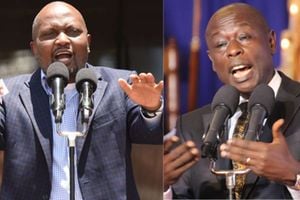Why Fairness Doctrine didn’t apply to newspapers, and other tall stories

Chama Ya Mapatano leader and presidential aspirant Damaris Too delivering her speech at Ufungamano House in Nairobi on March 30, 2022. In the Fairness Doctrine, newspapers didn’t have to abide by the public interest obligation of providing fair coverage.
Prof Ngotho wa Kariuki asks: “If the owner of a television station decides not to cover a particular candidates, isn’t that his right?” He was reacting to my article, “We need a Fairness Doctrine in TV coverage of presidential candidates” (Daily Nation, March 25, 2022).
The Fairness Doctrine, as conceived by the Americans, is predicated on the fact that broadcasters use a publicly owned resource — the radio frequencies or broadcast spectrum. So, they have a social obligation to serve the public interest. If a broadcaster refused to comply, he could lose his broadcasting licence. A licence is a permit to do something, which can be revoked. It’s not a right.
Paul Kimani, on the other hand, would like to see the Fairness Doctrine extended to newspapers. But the Fairness Doctrine applied only to radio and TV. Arguments that it should also apply to newspapers were rejected by the Supreme Court. The court argued that newspapers, unlike radio and TV, do not use the publicly owned frequencies. Therefore, they didn’t have to abide by the public interest obligation of providing fair coverage.
***
Readers have, over the past few months, been complaining in vain about the way the Seeds of Gold magazine is put together.
Lars Asker, a retired Swedish engineer who usually spends the European winter months in Mombasa, recently wrote: “I usually pull out the Seeds of Gold supplement and give it to my kulima (farmer) friends. But nowadays it’s not a pull-out; I have to cut out some loose separate pages.”
Another reader, who doesn’t want to be named, says: “I find the way the magazine is put together very irritating. People have complained, even to the Public Editor, but nothing is done. Is there a valid reason why your media planners plan it in such a horrible way that anybody who wants to keep a copy has to literally tear off pages and mess up the whole newspaper? It’s irritatingly messy.”
In newspapers, every page is linked to three others. This is because pages are created by printing on one sheet of paper and then folding it to make four pages. Thus, the number of pages are always in multiples of four. The Nation can only be, for example, 40 or 44 pages, not 41, 42 or 43.
So, as long as the Seeds of Gold has pages in multiples of four (four, eight, 12 and so on), it’s technically possible to produce it as a pull-out. The magazine has comprised eight pages since January. It is possible to have it produced as a pull-out. It is not rocket science.
***
Last Friday was April Fools’ Day. But the Nation didn’t publish a story that was an April Fools’ Day prank. That was quite a healthy change in newsroom culture and practice. The Nation has in the past carried fake news to fool (and, hopefully, amuse) readers on April 1. Just because it’s April Fools’ Day, a tradition borrowed from the West.
I’ve always argued against using newspapers space to fool readers. In 2011, I argued that April 1 foolery should be kept out of the paper (“When April Fools’ Day jokes and pranks are neither funny nor clever”—Daily Nation, April 1). In 2019, I argued that April Fools’ Day tricks are even dangerous (“Why the ‘Nation’ shouldn’t mess with readers on April Fool’s Day”, Daily Nation, April 4).
Disguising fake stories as genuine news is not only not funny; it’s also a double waste of valuable space and time as the story has to be told twice with the second one appearing the following day to say the first was a hoax.
I agree with a former public editor of the Toronto Star, who says fooling readers with pretend news shouldn’t be allowed because of “the grave dangers to our credibility” as a newspaper. “Truth is our currency—the foundation of our credibility,” she writes. “Why would we present false news as real and seek to fool readers into believing something that is untrue is true? Just for laughs?” (“Media tradition of April Fool’s Day jokes isn’t so funny now” (The Star, March 31, 2017).
Congratulations, Nation editors, for keeping the April 1 tomfoolery out of the paper.
The Public Editor is an independent news ombudsman who handles readers’ complaints on editorial matters including accuracy and journalistic standards. Email: [email protected]. Call or text 0721989264





